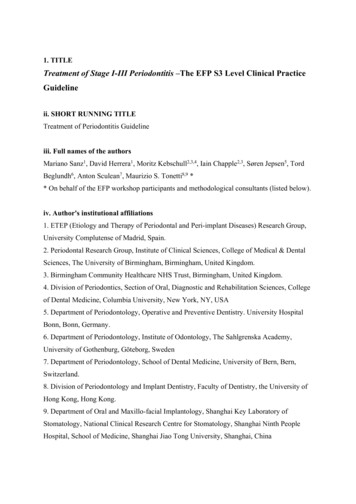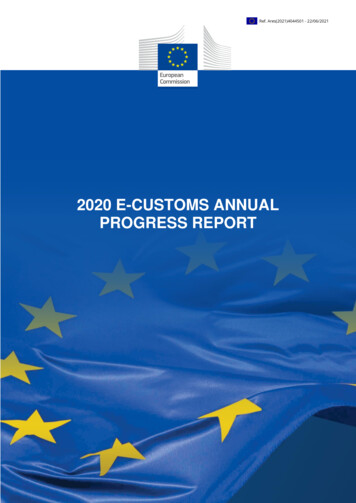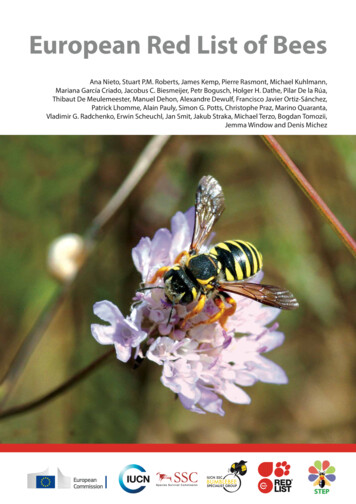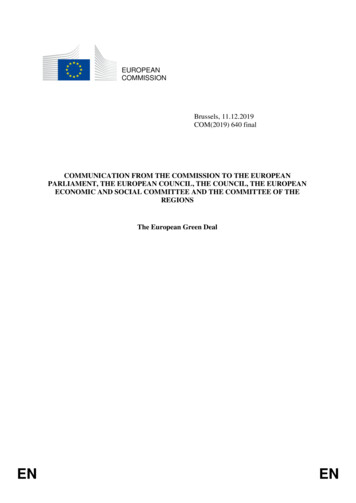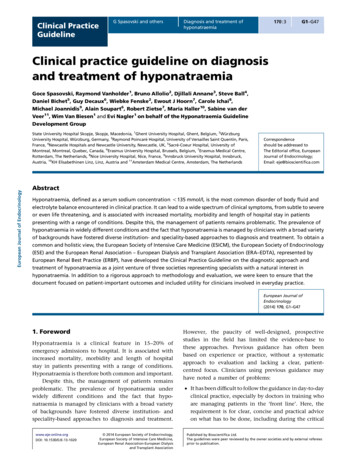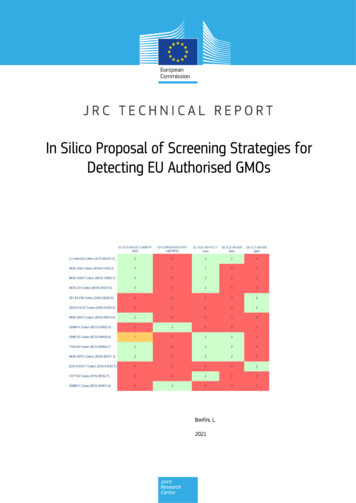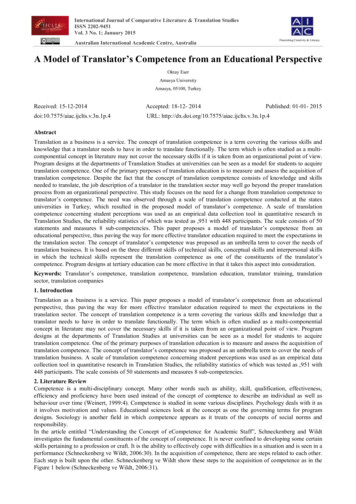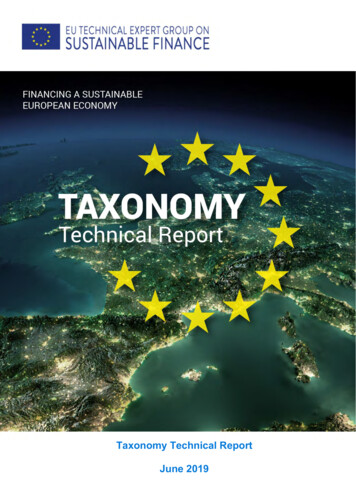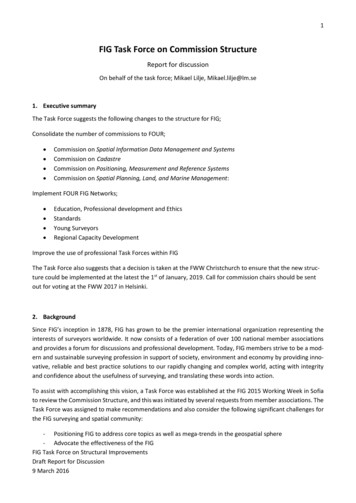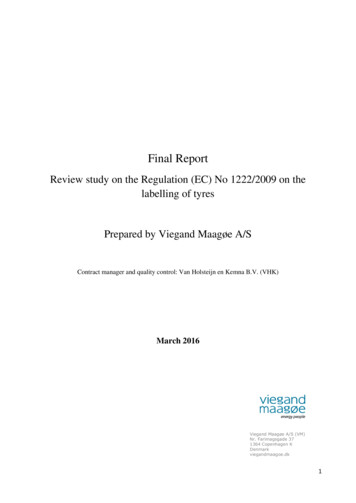
Transcription
Final ReportReview study on the Regulation (EC) No 1222/2009 on thelabelling of tyresPrepared by Viegand Maagøe A/SContract manager and quality control: Van Holsteijn en Kemna B.V. (VHK)March 2016Viegand Maagøe A/S (VM)Nr. Farimagsgade 371364 Copenhagen KDenmarkviegandmaagoe.dk1
Prepared for:European CommissionDG ENER C.3Office: DM24 4/149B-1049 Brussels, BelgiumContact person: Mr Juan Moreno AcedoEmail: juan.moreno-acedo@ec.europa.euProject website: http://www.labellingtyres.eu/With reference to Request for Services No. ENER/C3/2012-418-Lot2/07/2014-558, Reviewstudy on Regulation (EC) No 1222/2009 of the European Parliament and of the Council on thelabelling of tyres with respect to fuel efficiency and other essential parameters.In the context of Framework Contract reference ENER/C3/2012-418-Lot 2Specific contract no.: ENER/C3/2012-418-LOT2/07/2014-558/SI2.707241The information and views set out in this study are those of the author(s) and do notnecessarily reflect the official opinion of the Commission. The Commission does not guaranteethe accuracy of the data included in this study. Neither the Commission nor any person actingon the Commission’s behalf may be held responsible for the use which may be made of theinformation contained therein.This report has been prepared by the authors to the best of their ability and knowledge. Theauthors do not assume liability for any damage, material or immaterial, that may arise fromthe use of the report or the information contained therein. European Union, October 2015.Reproduction is authorised provided the source is acknowledged.More information on the European Union is available on the internet (http://europa.eu).2
Executive summaryReview study on Regulation (EC) 1222/200091 of the European Parliament and of the Council on thelabelling of tyres with respect to fuel efficiency and other essential parametersTyres, mainly because of their rolling resistance, account for 20-30 % of the fuel consumptionof vehicles2. Therefore, a reduction of the rolling resistance of tyres could contributesignificantly to the energy efficiency of road transport and thus to the reduction of emissions.However, tyres are characterised by a number of parameters, which are interrelated.Improving one parameter, such as rolling resistance, may have an adverse impact on otherparameters, such as wet grip, while improving wet grip may have an adverse impact onexternal rolling noise.In 2009, the European Parliament and the Council adapted the Tyre Labelling Regulation(Regulation (EC) No 1222/2009) to promote sustainable mobility in the EU. The Regulationentered into force on 1 November 2012. Its aim is to increase the safety as well as theeconomic and environmental efficiency of road transport by promoting fuel efficient and safetyres with low external rolling noise. The tyre labelling provides harmonised information aboutfuel-efficiency, wet grip and external rolling noise, as explained in more detail in Chapter 1Existing Legislation. The intention is to encourage the manufacturers to optimise relevantparameters beyond the standards already achieved and to influence end-users’ purchasingdecisions in favour of safer, quieter and more fuel-efficient tyres.The Tyre Labelling Regulation covers tyres for passenger cars (C1 tyres), tyres for lightcommercial vehicles (C2 tyres) and tyres for heavy-duty vehicles (C3 tyres)3. Retreaded tyres,studded tyres and tyres for a number of specific applications, such as racing and spare tyres,are exempted4. The Tyre Labelling Regulation Ranks tyre on a scale from ‘A’ to ‘G’ on both fuelefficiency and wet grip, whereas external rolling noise is shown as a measured value and athree-step scale. The label design is based on that from the Energy Labelling Directive 5 forenergy related products, since this design is well known by consumers 6.The Tyre Labelling Regulation is closely related to the Tyre Type Approval Regulation 7, which isdesigned to remove the worst tyres from the market in terms of the same parameters. It setsout minimum requirements for rolling resistance, wet grip (for C1 tyres only) and externalrolling noise. Furthermore, the Tyre Labelling Regulation is referred to in the Energy EfficiencyDirective 2012/27/EU8, which lays down requirements for public procurement of tyres in AnnexIII. Central Governments must purchase tyres of the highest fuel efficiency class, and in theirtenders for service contracts, require that service providers for the service in question only usetyres in the highest fuel efficiency class.Regarding the Review of the Tyre Labelling Regulation, Article 14 of the Regulation reads asfollows:1. The Commission shall assess the need to review this Regulation, taking into account,inter alia:1Regulation (EC) No 1222/2009 of the European Parliament and of the CouncilRegulation (EC) No 1222/2009 of the European Parliament and of the Council3Regulation (EC) No 661/2009 of the European Parliament and of the Council, Article 84Regulation (EC) No 1222/2009 of the European Parliament and of the Council, Article 2.2 details which tyres are notincluded in the scope of the Regulation5Directive 2010/30/EU of the European Parliament and of the Council6Regulation (EC) No 1222/2009 of the European Parliament and of the Council7Regulation (EC) No 661/2009 of the European Parliament and of the Council8Directive 2012/27/EU of the European Parliament and of the Council23
(a) the effectiveness of the label in terms of end-user awareness, in particular whetherthe provisions of Article 4(1)(b) are as effective as those of Article 4(1)(a) incontributing to the objectives of this Regulation;(b) whether the labelling scheme should be extended to include retreaded tyres;(c) whether new tyre parameters, such as mileage, should be introduced;(d) the information on tyre parameters provided by vehicle suppliers and distributors toend-users.According to this article, the need for a revision must be assessed, and the results of theassessment must be presented to the European Parliament and the Council. An importantaspect is to assess the end-users’ awareness and understanding of the label and thepossibilities to extend the labelling scheme to include additional types of tyres and new tyreparameters.In that sense, and in the context of the Framework Contract Lot 2: Review Studies and relatedtechnical assistance on eco-design and energy labelling implementing measures, signed on 23January 2013 between Van Holsteijn en Kemna BV and the Directorate General for Energy(reference ENER/C3/2012-418 Lot 2), the Directorate General requested a proposal for anassignment aimed at carrying out a Review study on Regulation (EC) No 1222/2009 of theEuropean Parliament and of the Council on the labelling of tyres with respect to fuel efficiencyand other essential parameters.The aim of the review study is to investigate the needs and possibilities for revision of theRegulation, assessing: The end-users’ understanding of the label and the consumers’ buying behaviour;The sufficiency of the information provided by vehicle suppliers and distributors on tyreparameters;The possibility to extend the labelling scheme to include retreaded tyres and mileage;The possibility to adapt the labelling requirements to technical progress of the gripgrading of tyres primarily designed to perform better in ice and/or snow conditions;The possibility to improve the clarity of the regulation, avoiding grey areas;The ability of the regulation to achieve market transformation;The differentiation on the level of enforcement of the regulation by the differentMember States and a potential reinforcement of market surveillance;Any other relevant aspects that might require an adaptation of the regulation, such asi.a. the handling of studded tyres or the possibility to establish a registration database.The methodology used to perform this review study is partially based on the MEErPmethodology (stock modelling and scenarios), with addition of surveys to consumers andstakeholders in the tyre supply chain and the assessment of market surveillance activities, andin a proportionate way on the Commission's Better Regulation Guidelines9 and the BetterRegulation criteria enshrined therein.Market transformationIn Chapter 3 Market Transformation achieved with existing legislation, the TyreLabelling Regulation’s effect on the C1, C2 and C3 replacement tyre markets are analysed interms of how the three labelling parameters have developed.9European Commission (2015), Commission staff working document “Better Regulation Guidelines”. es/toc guide en.htm4
The Tyre Labelling Regulation was implemented in November 2012. For all the performanceparameters included in the scheme (fuel efficiency, wet grip and external rolling noise), it hasbeen able to transform the market in a positive direction from 2013 to 2015, although thepositive tendency is less obvious for external rolling noise than for fuel efficiency and wet grip.Market data was purchased from two large databases, TOL 10 (Germany) and VACO11 (Holland),and supplemented with information from industry associations to create a tyre stock model foruse in scenario calculations. Analysis of the market data shows that the Tyre LabellingRegulation has driven an increased R&D and technology innovation effort, resulting inincreased wet grip performance of tyres, as well as optimisation of fuel efficiency leading todecreased fuel consumption.Two scenarios were modelled based on the market data: a Business As Usual (BAU) scenarioand an Optimised Implementation (OI) scenario. The BAU scenario represents the tyre label asit is now with no further changes and is based on linear extrapolation of the development ofthe three label parameters in the period from 2013-2015. The OI scenario represents a fastermarket penetration of high performing tyres, achieved through actions taken to increaseawareness and market surveillance efforts. With the BAU scenario, total CO2 emission savingsof 5.4 Mton is expected compared to 18.2 Mton with the OI scenario.Until now, the Tyre Labelling Scheme has only utilised a minor part of the fuel saving potential,because only few tyres are labelled in the best fuel efficiency classes. The extent of futuresavings depends on how effectively the labelling scheme is implemented and enforced as wellas manufacturers’ and consumers’ responses to the scheme.Survey of consumer awarenessSurveys were prepared and executed, as described in Chapter 2 Surveys and interviews, toassess the tyre buying behaviour of the end-users, the end-user awareness of the TyreLabelling Scheme, and the need for further information on the label. Focus was put on a largeC1 end-user survey with 6,000 private car owners in six EU countries 12, since the label isapplicable only to C1 and C2 tyres, and the C1 market is by far the largest. The C1 end-usersurvey was supported by information received from C2 and C3 end-users as well as tyresuppliers and distributors.The C1 end-user survey showed that around half of the private car owners in the surveyedcountries are aware of the tyre label, and that most (64 %) have medium confidence in thelabelling scheme. End-users answered that especially more market surveillance, includingtesting, is necessary to increase their confidence in the label.The survey showed that when purchasing tyres, C1 end-users find wet grip the most importantof the labelling parameters (62 % rated it “very important”) followed by fuel efficiency (34 %rated it “very important”) and lastly external rolling noise (21 % rated it “very important”).Regarding the need for further information on the label, 49 % found it “very important” toinclude snow and ice grip information, while 25 % found it “very important” to include mileageinformation.Regarding their last purchase of tyres, 85 % of the C1 end-users purchased tyres in a physicalshop, while 12 % purchased them through the internet, with 56 % planning to buy tyres on10Tyres online and Energy GmbH, database extractions from year 2012-2015, Hämmerling Group, Germany. Datasetcovering 2012-2015 with 30,000 tyres total.11Dutch Tyre and Wheel Trade Association, database extract from year 2013-2015, VACO, Netherlands. Datasetcovering top seven brands from 2013-2015, 2,500 tyre models total.121000 car owners form each of the countries: Italy, Sweden, France, UK, Finland, Germany.5
the internet in the future. Only 36 % of those buying tyres in a physical shop saw the tyresdisplayed before the purchase. Industry and market surveillance authorities agreed with thesefindings. The assessment of whether the provisions in article 4(1)(b) of the Regulation are aseffective as article 4(1)(a) is therefore obviated by the fact that end-users do not see thetyres. More focus should instead be on how to ensure proper provision of information to endusers prior to their purchase of new tyres.Based on the findings in the surveys, the following is proposed in order to make it more likelythat the consumers see the label or are informed about fuel efficiency class, wet grip class etc.before the purchase of new tyres: Online labelling. The label should be shown on the screen when tyres are offered forsale online (in web shops, etc.) as is already implemented for energy related productslabelled under the Energy Labelling Directive (2010/30/EU) 13.Obligation of the distributor to show the label of all tyres suggested to the end-usersduring a tyre purchasing process.Inclusion of information about the label performance parameters in advertisements,including the now omitted advertisements in billboards, newspapers, and magazines.Labelling of tyres when placed in the stock of distributors, preferably obliging labellingof all tyres. This would also make market surveillance easier to perform.Furthermore, it is recommended to conduct awareness campaigns to increase end-userknowledge of the labelling scheme. Especially C1 end-users are important to target, since C1tyres constitute the largest share of the tyre sales. The campaigns could be run at nationallevel by Member State Authorities, at EU level by the Commission or both. It is suggested thattyre suppliers and/or distributors are involved in the campaigns and that experiences fromprevious campaigns performed by Members States and others are taken into account.Information from vehicle suppliers and distributorsThe information on tyre label parameters provided by the vehicle suppliers and distributors toend-users was specifically assessed. According to The Tyre Labelling Regulation, vehiclesuppliers and distributors are obliged to provide end-users with information on tyre labellingparameters, if the end-users are offered a choice between different tyres to be fitted on thevehicle they are intending to acquire.In the review study, it was found that most end-users are not offered a choice betweendifferent tyres when purchasing a vehicle, which was confirmed by both vehicle suppliers anddistributors. According to market surveillance authorities (MSAs), market surveillance on thisprovision is complicated due to a lacking definition of when there is a choice, especially if thepurchase of an extra set of tyres for the vehicle is considered a choice.Based on the findings it is recommended to improve the regulation by obliging vehiclesuppliers and distributors always to provide end-users with information on all tyres (not thelabel itself), including situations when the end-user is not offered a choice between differenttyres to be fitted on the vehicle. This will make market surveillance less complicated, and willpresent end-users with knowledge of the tyre label.Extensions of the labelling schemeThe possibilities to extend the labelling scheme to include additional types of tyres and newperformance parameters were assessed. The extension assessments included two tyre types;13Directive 2010/30/EU of the European Parliament and of the Council6
studded tyres and retreaded C3 tyres, and three performance parameters; ice/snow grip,mileage and abrasion. The assessments include collection of market data, analysis of thetechnical progress and possibilities, analysis of environmental impact (based on scenarios) anddevelopment of policy recommendations.As of today, there are several marketing terms to define tyres performing well in wintryconditions (e.g. “winter tyres”, “Nordic winter tyres”, “all season tyres”) for which no legaldefinition exist. However, UNECE Regulation 117 legally defines “severe snow tyres”, which aretyres that based on a snow grip test can be approved for bearing the 3-Peak Mountain SnowFlake (3-PMSF) symbol. Hence, inclusion of snow grip as a parameter is technically possiblethrough this standardised 3-PMSF test. It is recommended to include the 3-PMSF logo as anindicator for snow grip in the labelling scheme as additional information to the wet grip scale,on a voluntary basis, and consider making the 3-PMSF logo mandatory on the label, in case itis shown on the tyre sidewall. The test is applicable for all tyre types (C1, C2 and C3).Furthermore, it is recommended to use the upcoming “Nordic winter tyre” ice grip test andlogo as additional information on ice grip performance for C1 tyres. The inclusion of theperformance parameters should be assessed in terms of user understanding, to avoidproviding information that might mislead end-users.The assessment the inclusion of mileage as a parameter showed that external factors and useconditions affect tyre mileage significantly, limiting the effect of technological development. Inaddition, the only known test method (for C1 tyres only), which is currently only applicable inthe USA, gives uncertain and non-reproducible results. The same applies to particle emissionsfrom tyre abrasion, which is affected largely by external parameters, and no standard methodfor measuring the effects currently exists. It is therefore not recommended to include any ofthese parameters in the Tyre Labelling Regulation.The assessment of the inclusion of retreaded tyres concerns only C3 retreaded tyres, since themarket share of C1 and C2 retreaded tyres are below 2 %, while that of C3 retreaded tyres isaround 45 %14. The main barrier of inclusion is the testing, since retreaded tyres are oftenproduced in small series, and each new combination of carcass, tread and retreadingtechnology gives different tyre characteristics. A tool has been developed in the ReTyreProject15 for calculating rather than testing the performance of retreaded C3 tyres. There areopposing opinions in the industry of the applicability and accuracy of the ReTyre tool forlabelling purposes. It is therefore recommended not to include retreaded C3 tyres in theLabelling Regulation before technical issues with the ReTyre tool as well as questions aboutmaintenance and availability of the tool for all retreading facilities are solved.The assessment of studded tyres shows that the market share is very low in all but the threeNordic countries (Sweden, Norway and Finland), and the potential fuel saving is therefore verylimited. One reason for the low market share is that use of studded tyres is prohibited in manyEuropean countries. Furthermore, the current test standards cannot be used for testingstudded tyres, and it is therefore not recommended to include them in The Tyre LabellingRegulation.Market surveillance in MSTo ensure compliance with the provisions in the Tyre Labelling Regulation by suppliers anddistributors, Members States are responsible for conducting market surveillance and regularcontrols in line with the Market Surveillance Regulation 16. Due to the lack of a comprehensive141516Ruud Spuijbroek, Secretary at Bipaver (2015), personal communication on email September 16th 2015.Retyre (2014), Main website. Link: http://www.retyre-project.eu/Regulation (EC) No 765/2008 of the European Parliament and of the Council7
overview of market surveillance activities in EU Member States regarding the Ttyre LabellingRegulation, such an overview was sought established in the review study. Interviews wereconducted with MSAs in various Member States. The investigation showed that the marketsurveillance effort varies greatly throughout the EU, and in general, the only widespreadactivity is shop inspections. Technical documentation is rarely requested for marketsurveillance purpose and there is a severe lack of market surveillance testing due to a lack ofresources and limited number of testing facilities. Furthermore, the few Member States whoconducted tests, found that the repeatability/reproducibility of the test results was very low.The low market surveillance decreases end-user confidence in the tyre label, and tyre dealersreport that due to lack of market surveillance inspections, they have decreased their efforts toeducate their employees in informing end-users of the labelling scheme. To reinforce marketsurveillance and improve enforcement of the Regulation, it is therefore suggested to: Solve existing problems with high variety of test conditions and start working onimproving the wet grip test method.Increase the visibility of market surveillance activities carried out by Member States.MSAs should be obliged to publish results of inspections (i.e. number of shopinspections and test, and compliance levels) and make them available to industry anddealers, for instance in the proposed registration database or the Tyres ADCOwebsite17.Not extend the labelling scheme to cover mileage or abrasion because this willsignificantly increase the costs for market surveillance. Extra cost will reduce thenumber of inspections, and fewer inspections could easily hamper the consumers’,dealers’ and industry’s confidence in the label scheme.Perform more joint actions testing in line with the upcoming joint action on labellingtyre testing funded under the EU Horizon 2020 Research and Innovation programme.Establish a digital registration database, where all tyres should be registered prior tobeing placed on the European market. The database should be separated into apublically available section and a section only available to market surveillanceauthorities.17European Commission (2015), Tyres ADCO /index.cfm?do groupDetail.groupDetail&groupID 2808&Lang EN8
Table of ContentsTable of Contents . 9List of Appendices. 12Introduction . 13Purpose of the study . 14Study approach . 151 Existing legislation . 161.1 Scope . 161.2 Classification and performance measures . 161.2.1 Fuel efficiency class . 171.2.2 Wet grip class . 181.2.3 External rolling noise class and measured value . 191.3 Test standards . 201.4 Responsibilities . 201.4.1 Tyre suppliers and distributors . 201.4.2 Vehicle suppliers and distributors . 211.4.3 Member States . 212Surveys and interviews . 222.1 Selection of target groups . 222.1.1 Tyre suppliers (manufacturers and importers) . 232.1.2 Tyre dealers . 232.1.3 Vehicle suppliers and distributors . 232.1.4 C1 end-users . 242.1.5 C2 end-users . 252.1.6 C3 end-users . 252.2 Results of surveys and interviews . 252.2.1 Tyre suppliers . 252.2.2 Tyre dealers . 262.2.3 Vehicle suppliers and distributors . 262.2.4 C1 end-users . 272.2.5 C2 end-users . 322.2.6 C3 end-users . 333. Market transformation achieved with existing legislation . 343.1 Data . 343.2 Market transformation on fuel efficiency (Rolling Resistance) . 343.3 Market transformation on wet grip . 363.4 Market transformation on external rolling noise . 379
4. Market development potentials . 394.1 Modelling . 394.2 Rolling resistance development . 404.2.1 Energy savings . 424.3 Wet grip development . 434.4 External rolling noise development . 454.5 Summary of market development potentials . 465.Inclusion of new performance parameters . 475.1 Ice and snow grip . 475.1.1 Definitions of Snow tyres and marketing terms . 475.1.3 Including snow and ice grip in the labelling scheme . 495.2 Mileage . 525.2.1 Factors affecting mileage . 525.2.2 Test standards for mileage . 535.2.3 Scenarios for increased mileage . 545.2.4 Results of increased mileage scenarios . 565.2.5 Conclusions on mileage . 585.3 Abrasion . 585.3.1 Abrasion and particle emissions . 585.3.2 Test standard for particle emissions . 595.3.3 Environmental impact of Abrasion . 605.3.4 Conclusions on Abrasion . 606. Inclusion of new tyre types . 616.1 Retreaded tyres . 616.1.1 Retreading process . 616.1.2 Test standards for retreaded C3 tyres . 626.1.3 Scenarios for including retreaded C3 tyres . 646.1.4 Results of retreaded C3 inclusion . 646.1.5 Current savings from retreaded tyres . 666.1.6 Conclusions on retreaded C3 tyres .
as manufacturers' and consumers' responses to the scheme. Survey of consumer awareness Surveys were prepared and executed, as described in Chapter 2 Surveys and interviews, to assess the tyre buying behaviour of the end-users, the end-user awareness of the Tyre Labelling Scheme, and the need for further information on the label.


